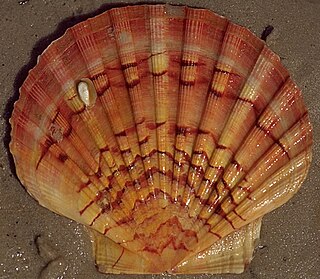
Acinonyx is a genus within the cat family. The only living species of this genus, the cheetah A. jubatus lives in open grasslands of Africa and Asia.

Bivalvia, in previous centuries referred to as the Lamellibranchiata and Pelecypoda, is a class of marine and freshwater molluscs that have laterally compressed bodies enclosed by a shell consisting of two hinged parts. Bivalves as a group have no head and they lack some usual molluscan organs like the radula and the odontophore. They include the clams, oysters, cockles, mussels, scallops, and numerous other families that live in saltwater, as well as a number of families that live in freshwater. The majority are filter feeders. The gills have evolved into ctenidia, specialised organs for feeding and breathing. Most bivalves bury themselves in sediment where they are relatively safe from predation. Others lie on the sea floor or attach themselves to rocks or other hard surfaces. Some bivalves, such as the scallops and file shells, can swim. The shipworms bore into wood, clay, or stone and live inside these substances.

The eastern oyster —also called Wellfleet oyster, Atlantic oyster, Virginia oyster, or American oyster—is a species of true oyster native to the eastern seaboard and Gulf of Mexico coast of North America. It is also farmed in Puget Sound, Washington, where it is known as the Totten Inlet Virginica. Eastern oysters are and have been very popular commercially. Today, less than 1% of the original 17th-century population is thought to remain in the Chesapeake Bay and its tributaries, although population estimates from any era are uncertain. The eastern oyster is the state shellfish of Connecticut, its shell is the state shell of Virginia and Mississippi, and its shell in cabochon form is the state gem of Louisiana.

Crassostrea is a genus of true oysters containing some of the most important oysters used for food. Some species in the genus have been moved to the genus Magallana.

Christian Gottlieb Ferdinand Ritter von Hochstetter was a German-Austrian geologist.

The Pacific oyster, Japanese oyster, or Miyagi oyster, previously and currently also known as Crassostrea gigas, considered by part of the scientific community to be the proper denomination as an accepted alternative in WoRMS, is an oyster native to the Pacific coast of Asia. It has become an introduced species in North America, Australia, Europe, and New Zealand.

Ostrea edulis, commonly known as the European flat oyster, is a species of oyster native to Europe. In the British Isles, regional names include Colchester native oyster, mud oyster, or edible oyster. In France, Ostrea edulis are known as huîtres plates except for those that come from the Belon River estuary in Brittany, France, which are known as 'Belons'.

Pecten jacobaeus, the Mediterranean scallop, is a species of scallop, an edible saltwater clam, a marine bivalve mollusc in the family Pectinidae, the scallops.

Andrias scheuchzeri is an extinct species of giant salamander, which only is known from fossils. It lived from the Oligocene to the Pliocene. It and the extant A. davidianus cannot be mutually diagnosed, and the latter, only described in 1871, is therefore sometimes considered a synonym of the former.

Psephophorus is an extinct genus of sea turtle that lived from the Oligocene to the Pliocene. Its remains have been found in Europe, Africa, North America, and New Zealand. It was first named by Hermann von Meyer in 1847, and contains seven species, P. polygonus, P. calvertensis, P. eocaenus, P. oregonesis, P. californiensis, P. rupeliensis, P. scaldii, and a species discovered in 1995, P. terrypratchetti.

Pycnodonte is a genus of extinct oysters, fossil marine bivalve mollusks in the family Gryphaeidae, the foam oysters or honeycomb oysters. Shells of species in this genus are found around the world in fossil shell beds from the Valanginian to the Early Pleistocene. They are a commonly found fossil in Cretaceous shellbeds of the Navesink Formation in New Jersey.

Fordilla is an extinct genus of early bivalves, one of two genera in the extinct family Fordillidae. The genus is known solely from Early Cambrian fossils found in North America, Greenland, Europe, the Middle East, and Asia. The genus currently contains three described species, Fordilla germanica, Fordilla sibirica, and the type species Fordilla troyensis.

The hooded oyster or Natal rock oyster is a species of rock oyster found mainly in the Indo-Pacific Ocean.

Persististrombus coronatus is an extinct species of fossil true conch from the Late Miocene to Pliocene.

Filopaludina martensi is a species of large freshwater snail with a gill and an operculum, an aquatic gastropod mollusk in the family Viviparidae.

Gigantopecten is a genus of fossil scallops, marine bivalve mollusks in the family Pectinidae, the scallops.

Gigantopecten latissimus is a species of fossil scallop, a marine bivalve mollusk in the family Pectinidae, the scallops. This species lived during the Miocene and the Pliocene. Fossils have been found in the sediments of France and Spain.

Hyotissa semiplana is an extinct species of large saltwater oysters, a fossil marine bivalve mollusk in the family Gryphaeidae, the foam oysters
Marshallena neozelanica is a species of sea snail, a marine gastropod mollusk in the family Horaiclavidae.
Clavatoma pulchra is an extinct species of sea snail, a marine gastropod mollusk in the family Pseudomelatomidae, the turrids and allies

















